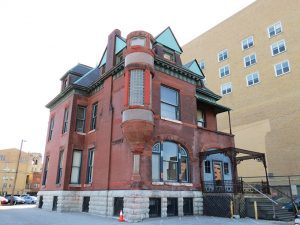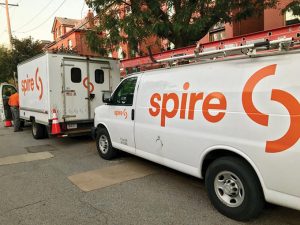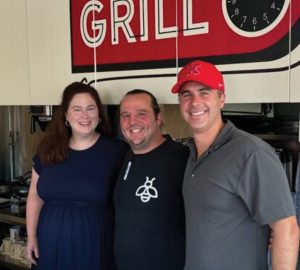 st. louis | The stately Victorian-era Culver House has been razed to make room for the expansion of Powell Hall in Grand Center. That’s just great for Powell Hall and aficionados of the fine classical music as performed by St. Louis Symphony Orchestra, but it does beg the question: Where are the StL’s priorities when it comes to historic preservation? This is the same city that recently awarded historical significance to an office building downtown that’s just 46 years old: The AT&T tower. It’s 19 years shy of Medicare, for heaven’s sake! It may be the tallest building in the state, but what’s its historical significance besides having been owned by a monopoly at one time? The new owners bought it for a song, and now they’re welcome to who knows how many dollars in tax incentives for its restoration? But as what? In case nobody told them, there’s this seemingly immortal virus thing still going on, which has made even the highest higher-ups at the biggest corporate entities rethink who absolutely has to come to a downtown office when they can just Zoom in. Here’s a four-word hint: They’re. Not. Coming. Back. But, back to Grand Center: It would have cost a couple million dollars to move Culver House onto land that a local businessman had said he would donate. And St. Louis Symphony Orchestra officials insisted it could not have been incorporated into the ultramodern expansion designed for the lot where it had stood. I’m not entirely convinced. I’d bet our very own Paul Doerner could have worked up some intriguing renderings of the possibilities for his Homework column in this fine magazine. But Culver House had been demolished by the time I had the idea. And Paul’s a residential architect, anyhow. No matter. As my distinguished father has been wont to say, “Too soon old, too late smart.”
st. louis | The stately Victorian-era Culver House has been razed to make room for the expansion of Powell Hall in Grand Center. That’s just great for Powell Hall and aficionados of the fine classical music as performed by St. Louis Symphony Orchestra, but it does beg the question: Where are the StL’s priorities when it comes to historic preservation? This is the same city that recently awarded historical significance to an office building downtown that’s just 46 years old: The AT&T tower. It’s 19 years shy of Medicare, for heaven’s sake! It may be the tallest building in the state, but what’s its historical significance besides having been owned by a monopoly at one time? The new owners bought it for a song, and now they’re welcome to who knows how many dollars in tax incentives for its restoration? But as what? In case nobody told them, there’s this seemingly immortal virus thing still going on, which has made even the highest higher-ups at the biggest corporate entities rethink who absolutely has to come to a downtown office when they can just Zoom in. Here’s a four-word hint: They’re. Not. Coming. Back. But, back to Grand Center: It would have cost a couple million dollars to move Culver House onto land that a local businessman had said he would donate. And St. Louis Symphony Orchestra officials insisted it could not have been incorporated into the ultramodern expansion designed for the lot where it had stood. I’m not entirely convinced. I’d bet our very own Paul Doerner could have worked up some intriguing renderings of the possibilities for his Homework column in this fine magazine. But Culver House had been demolished by the time I had the idea. And Paul’s a residential architect, anyhow. No matter. As my distinguished father has been wont to say, “Too soon old, too late smart.”
 spanish lake
spanish lake
Giraffes, zebras and white rhinos in the area of Spanish Lake? Oh, my! You’ve probably heard there’s going to be a north county annex to our beloved Saint Louis Zoo. Critters, mostly hooved mammals, will start arriving next year. But members of the public won’t be able to visit for several years. There’s a grass issue, for one thing. The acreage formerly was occupied largely by the recreational complex for the metro pipefitters union and the former Emerald Greens golf course. Grasses ideal for iron shots or putting are generally inadequate for grazing. So before endangered and critically endangered species can have babies up there, the staff at Zoo North is growing acres and acres of baby grass: sideoats grama, little bluestem, Virginia wildrye and eastern gamagrass. But before we veer too much into the weeds, did you really think the StL would embark on something this elaborate without having someone to thank via the name? It’s not ‘Zoo North,’ but actually—take a deep breath—the St. Louis Zoo WildCare Park Kent Family Conservation and Animal Science Center. Whew! The center will devote approximately 61 acres, of the 425 total, to conservation breeding of species that would not be long for this world if concerted efforts were not undertaken. Zoo officials estimate the $230 million park will completely open to the public in 2027. At the outset, six species will be up yonder: Grevy’s zebra and addax in 2023—by 2027, mountain bongo, Somali wild ass, roan antelope and Przewalski’s horse. About another dozen species eventually will join them, some from our zoo, some from elsewhere, depending on evolving conservation needs. Safaris on the property? Sure. Glamping? Well, yep. There’ll also be an 11-story enclosed balloon tower that will rise to provide awe-inspiring views. Visit stlzoo.org/about/wildcare-park.
 the metro
the metro
Nothing changes if nothing changes, a would-be philosopher said one day, in perhaps the first-ever example of a BGO. (If not immediately apparent, ‘BGO’ stands for Blinding Glimpse of the Obvious.) Many St. Louisans seem to be most comfortable with some things just the way they’ve seemed to have been forever. Take Highway 40. It’s been officially Interstate 64 for years now, but not to natives. Well, in the 1950s there was this TV-repair shop in south St. Louis that evolved into the popular appliance retailer, Goedeker’s. But the family name went away recently when the company bought another, larger appliance company in the northeast. It has renamed itself… Polished. Huh? Um, give me a moment. Well, appliances always look polished, right? Ah, marketing people. They make such a fuss over rebranding, which involves arriving at a new name that might make sense to a few, but is a head scratcher to most everybody else. As a former marketing communications exec, I can report the requisite brainstorms interrupt the workdays of everyone from the CEO and department heads on down. I can only assume that’s how Laclede Gas Co. came up with its truly knuckleheaded new name: Spire. I mean, we know Ralston Purina became Nestlé because of a merger. But the utility company you begrudgingly pay every month because you have to? I suspect all that rebranding must have cost close to a gazillion dollars, including those brand-new, bright orange, inscrutable, logos on all those trucks and everything. It doesn’t make me feel any differently about the gas company, except wondering where it hit our checkbook. Each truck must have a cost …
notable neighbors
the j
Us: Klezundheit! You: Did somebody sneeze? Us: No, we just love the name of this klezmer band playing at Sababa, an outdoor festival showcasing the vibrancy of contemporary Jewish culture. Where, when and all that? It’s at WashU on Sunday, Sept. 18, from 10 a.m. to 5 p.m. Sababa will feature local, regional and national visual artists, culinary experiences and the unique musical stylings of Sheldon Low, Six13 and Klezundheit. That’s great, which happens to be one way to define Sababa—it’s also modern Hebrew slang for ‘awesome,’ or ‘cool.’ What’s the skinny on all this? First of all, it’s free! Now, we’ll introduce you to Diane Maier and Judy Kramer, who work at The J and are herding the cats for Sababa, so to speak. They’re both ‘Notable Neighbors,’ indeed! We got somewhat acquainted with several buildings on the Millstone Campus at The J until Maier managed to guide us via smartphone to where we were scheduled to meet her. Despite having been vaccinated and boosted against COVID-19, Kramer had contracted the nasty virus and was at home recovering. Maier put her on speakerphone. This is the 2nd annual Sababa; the inaugural event was held before the pandemic interrupted and upset the pastrami cart. (BTW: Pastrami, hot dogs and popcorn will be among the complimentary food items available.) Maier grinned. “We’ve been planning this for three years, so we have dotted every i and crossed every t,” she said. “With COVID, nobody feels like they’ve had a chance to see anybody,” Kramer interjected. Maier said she always tries to take in the Greek festival and is confident everyone will feel comfortable at Sababa, regardless of their background. “St. Louis is all about that. Anyone can go to everybody’s everything,” she exclaims. Activities for kids include a scavenger hunt, magician and jugglers, although those last two may fool or amaze anyone at any age. Klezundheit will put their spin on Jewish folk tunes. A cappella voices will fill the air. Performances will start with an all-vocal combo composed of WashU students, followed by the other acts: Six13 is a secular men’s a cappella group. “Sheldon Low is a St. Louisan you could characterize as the Raffi of the new generation,” Maier says. The event will occupy the Simon Hall parking lot, directly across from the music building. A juried art show is part of the mix (entries closed July 15). Kramer emphasizes that everyone is welcome: “The better we know about each other, the better this world will be.” For more info or to volunteer, visit sababastl.com.









